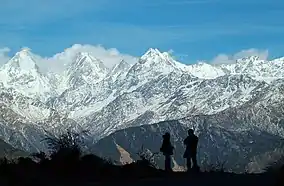| Askot Musk Deer Sanctuary | |
|---|---|
IUCN category IV (habitat/species management area) | |
 Panchchuli Peaks, near Munsiyari, Uttarakhand | |
| Location | Uttarakhand, India |
| Nearest city | Didihat |
| Coordinates | 30°07′15″N 80°39′09″E / 30.12083°N 80.65250°E |
| Area | 599.93 km2 (231.63 sq mi) |
| Established | 1986 |
Askot Musk Deer Sanctuary is located 54 km (34 mi) from Pithoragarh near Askot in Uttarakhand state of India. This sanctuary has been set up primarily with the object of conserving the musk deer (Moschus leucogaster) and its habitat. Intensive efforts have been initiated to conserve this rare species. Other mammals found in this sanctuary include the Bengal tiger,[1] Indian leopard, Himalayan jungle cat, civet, barking deer, serow, goral and Himalayan brown bear. Many species of high altitude birds are also found in this sanctuary.
Geography
Askot Wildlife Sanctuary, with altitude range from 600 m (2,000 ft) to 6,905 m (22,654 ft) is located in the Pithoragarh district of Kumaun. It lies between 29°46'45" to 30°27'45"N latitude and 81°01'53" to 80°16'25"E longitude (central coordinate: 30°07′15″N 80°39′09″E / 30.12083°N 80.65250°E) and covers almost 600 km2 (230 sq mi). The River Kali forms the international boundary and separates it from Nepal in the east and to the west it is bounded by West Almora Forest Division, to the north by Tibet and the south by Pithoragarh Forest Division.
The famous peaks: Panchchuli, Neodhura, Naukana, Chhiplakot, Najirikot; the passes: Lipu lekh, Lumpiya lekh and Mankshang lekh: and the religious places: Bhanar, Chiplakot, Niirikot, Panchachuli, Kalapani and Chota Kailash (Adi Kailash) form a part of the Sanctuary. The Dhauli and Ikli rivers originate from the area and Gori Ganga passes through it. The forest blocks: Rugling, Jyotigad, Hiragumarhi, Duk, Sobla, East Ghandhura, West Ghandhura, Maitham, Akla and Daphia are biodiversity rich habitats of the Sanctuary.[2]
References
- ↑ HT Correspondents; Dehradun (31 July 2016). "Tiger spotted above 12,000 ft in Uttarakhand, experts say 'ominous'". Hindustan Times. Retrieved 1 August 2016.
- ↑ S.S. Samant; U. Dhar & R.S. Rawal (1998), "Biodiversity status of a protected area in West Himalaya: Askot Wildlife Sanctuary" (PDF), International Journal of Sustainable Development, Almora, IN, vol. World Ecology- 5, pp. 194–203
External links
- Askot Musk Deer Sanctuary Official site Archived 3 August 2016 at the Wayback Machine